ANU scientists use deep planetary scan to confirm Martian core
Sunday, 30 October 2022 01:05 Seismologists from The Australian National University (ANU) have developed a new method to scan the deep interior of planets in our solar system to confirm whether they have a core at the heart of their existence.
The scanning method, which works in a similar way to an ultrasound scan using sound waves to generate images of a patient's body, requires only a single seismometer on a planet's
Seismologists from The Australian National University (ANU) have developed a new method to scan the deep interior of planets in our solar system to confirm whether they have a core at the heart of their existence.
The scanning method, which works in a similar way to an ultrasound scan using sound waves to generate images of a patient's body, requires only a single seismometer on a planet's Spectral evolution of a dark asteroid surface after ten years of space weathering
Sunday, 30 October 2022 01:05 When asteroid 596 Scheila collided with an object in the asteroid belt between Mars and Jupiter in December 2010, a fresh layer of material was exposed on the asteroid surface . An international research team observed the spectrum from the asteroid approximately ten years later, to see how space weathering affects the surface over a genuine timescale. Within the uncertainty of the observations,
When asteroid 596 Scheila collided with an object in the asteroid belt between Mars and Jupiter in December 2010, a fresh layer of material was exposed on the asteroid surface . An international research team observed the spectrum from the asteroid approximately ten years later, to see how space weathering affects the surface over a genuine timescale. Within the uncertainty of the observations, Scientists utilize lunar soils to sustainably supply oxygen and fuels on moon in an unmanned manner
Sunday, 30 October 2022 01:05 Building up the lunar settlement is the ultimate aim of lunar exploitation since human's first step on the moon. Yet, limited fuel and oxygen supplies restrict human survival on the moon. Combining photovoltaic and electrocatalysis, the artificial production of hydrocarbon fuels along with oxygen using carbon dioxide and water as the feedstocks has been demonstrably feasible on the earth and kno
Building up the lunar settlement is the ultimate aim of lunar exploitation since human's first step on the moon. Yet, limited fuel and oxygen supplies restrict human survival on the moon. Combining photovoltaic and electrocatalysis, the artificial production of hydrocarbon fuels along with oxygen using carbon dioxide and water as the feedstocks has been demonstrably feasible on the earth and kno Centaur issue delays JPSS-2 launch
Saturday, 29 October 2022 22:04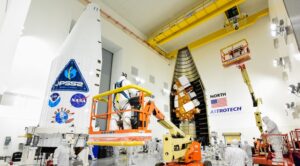
The launch of a polar-orbiting weather satellite and reentry technology demonstration will be delayed more than a week because of a battery problem with the upper stage of their rocket, NASA announced Oct.
Psyche launch rescheduled for October 2023
Saturday, 29 October 2022 03:24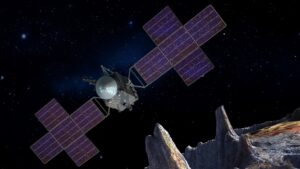
A NASA mission to an asteroid that missed its launch window this fall because of technical issues has been rescheduled for launch next October.
The post Psyche launch rescheduled for October 2023 appeared first on SpaceNews.
Constellation antenna provider SatixFy goes public after SPAC merger
Friday, 28 October 2022 19:45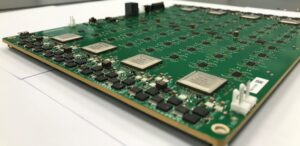
Satcoms equipment maker SatixFy started trading publicly Oct. 28 after its stock listing overcame waning investor interest in blank check mergers and the death of its co-founder and former CEO.
The post Constellation antenna provider SatixFy goes public after SPAC merger appeared first on SpaceNews.
NASA's Lunar Flashlight ready to search for the Moon's water ice
Friday, 28 October 2022 19:21
It's known that water ice exists below the lunar regolith (broken rock and dust), but scientists don't yet understand whether surface ice frost covers the floors inside these cold craters. To find out, NASA is sending Lunar Flashlight, a small satellite (or SmallSat) no larger than a briefcase. Swooping low over the lunar South Pole, it will use lasers to shed light on these dark craters—much like a prospector looking for hidden treasure by shining a flashlight into a cave.
NASA continues Psyche asteroid mission
Friday, 28 October 2022 19:18
NASA announced Friday the agency decided its Psyche mission will go forward, targeting a launch period opening on Oct. 10, 2023.
Earlier this year, Psyche missed its planned 2022 launch period as a result of mission development problems, leading to an internal review of whether the mission would be able to overcome these issues to successfully launch in 2023.
This continuation/termination review was informed by a project-proposed mission replan and a separate independent review, commissioned in June by NASA and the agency's Jet Propulsion Laboratory in Southern California, that investigated causes for the delay.
"I appreciate the hard work of the independent review board and the JPL-led team toward mission success," said Thomas Zurbuchen, associate administrator of NASA's Science Mission Directorate in Washington. "The lessons learned from Psyche will be implemented across our entire mission portfolio. I am excited about the science insights Psyche will provide during its lifetime and its promise to contribute to our understanding of our own planet's core.
NASA and ESA agree on next steps to return Mars samples to Earth
Friday, 28 October 2022 17:49
The next step in the unprecedented campaign to return scientifically selected samples from Mars was made on Oct. 19 with a formal agreement between NASA and its partner ESA (European Space Agency). The two agencies will proceed with the creation of a sample tube depot on Mars. The sample depot, or cache, will be at "Three Forks," an area located near the base of an ancient river delta in Jezero Crater.
This cache will contain samples from carefully selected rocks on the surface of Mars—samples that can help tell the story of Jezero Crater's history and how Mars evolved, and could perhaps even contain signs of ancient life.
Scientists investigate using lunar soils to sustainably supply oxygen and fuels on the moon
Friday, 28 October 2022 16:32
Building up a lunar settlement has been the ultimate aim of lunar exploitation since humanity's first step on the moon. Yet, limited fuel and oxygen supplies restrict human survival on the moon.
Combining photovoltaic and electrocatalysis, the artificial production of hydrocarbon fuels along with oxygen using carbon dioxide and water as the feedstocks has been demonstrably feasible on the Earth and is recognized as a potential strategy to be imitated in extraterrestrial sites. With the rapid progress of moon exploration, researchers have discovered that the moon's surface has considerable carbon dioxide and water reserves, which further confirms the feasibility of the idea.
Against this background, the joint research team of the University of Science and Technology of China, Nanjing University and China Academy of Space Technology found that the lunar soil brought back by the Chang'e 5 mission can be used as a catalyst to drive the electrocatalytic CO2 conversion for fuel and oxygen production.
Photo from NASA satellite shows the sun was 'smiling' this week
Friday, 28 October 2022 15:20
The sun was in a good mood this week, or at least that's what it looked like in a photo published by NASA.
A photo of the sun taken from a NASA satellite and time-stamped Thursday morning appears to show a smile on the surface of our nearest star.
It's not the first time this week the cheerful pattern appeared.
"Today, NASA's Solar Dynamics Observatory caught the sun 'smiling,'" NASA said in a Wednesday tweet. "Seen in ultraviolet light, these dark patches on the sun are known as coronal holes and are regions where fast solar wind gushes out into space."
According to SpaceWeather.com, the sun is spewing a triple stream of solar wind toward Earth. This could produce auroras here on Earth as early as Saturday, the website said.
The Solar Dynamics Observatory is a satellite that's in orbit around the Earth, with sensors pointed at the sun to take a variety of measurements of the sun and solar activity.
One of the mission's goals is to see how the sun's magnetic field is generated and structured, and how it impacts life on Earth and our telecommunications systems.
Haunting portrait: Webb reveals dust and structure in Pillars of Creation
Friday, 28 October 2022 13:00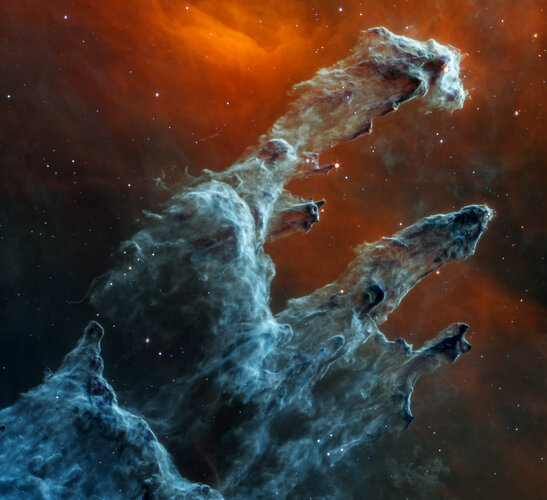
This is not an ethereal landscape of time-forgotten tombs. Nor are these soot-tinged fingers reaching out. These pillars, flush with gas and dust, ‘bury’ stars that are slowly forming over many millennia. The NASA/ESA/CSA James Webb Space Telescope has snapped this eerie, extremely dusty view of the Pillars of Creation in mid-infrared light – showing us a new view of a familiar landscape.
Webb’s instruments showcase the Pillars of Creation (slider)
Friday, 28 October 2022 13:00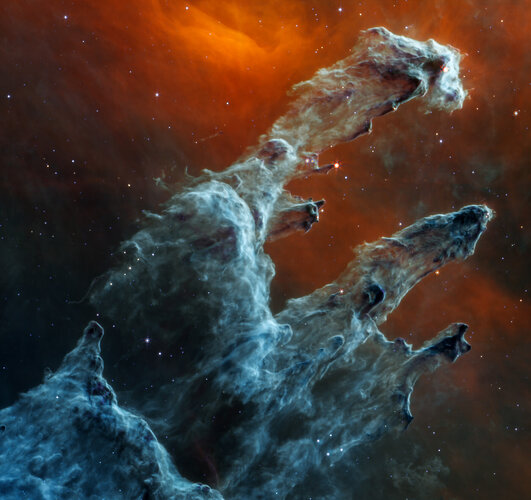 Image:
Image:
The NASA/ESA/CSA James Webb Space Telescope has revealed two new views of the Pillars of Creation, which was made famous by the NASA/ESA Hubble Space Telescope in 1995, and again in 2014.
On the left is Webb’s Mid-Infrared Instrument (MIRI) image. Interstellar dust cloaks the scene. And while mid-infrared light specialises in detailing where dust is, the stars aren’t bright enough at these wavelengths to appear. Instead, these looming, leaden-hued pillars of gas and dust gleam at their edges, hinting at the activity within. Learn more about this image here.
On the right is Webb’s
Webb's portrait of the Pillars of Creation (MIRI)
Friday, 28 October 2022 13:00 Image:
Image:
The NASA/ESA/CSA James Webb Space Telescope’s mid-infrared view of the Pillars of Creation strikes a chilling tone. Thousands of stars that exist in this region disappear from view — and seemingly endless layers of gas and dust become the centrepiece.
The detection of dust by Webb’s Mid-Infrared Instrument (MIRI) is extremely important — dust is a major ingredient for star formation. Many stars are actively forming in these dense blue-grey pillars. When knots of gas and dust with sufficient mass form in these regions, they begin to collapse under their own gravitational attraction, slowly heat up, and eventually
Week in images: 24-28 October 2022
Friday, 28 October 2022 12:15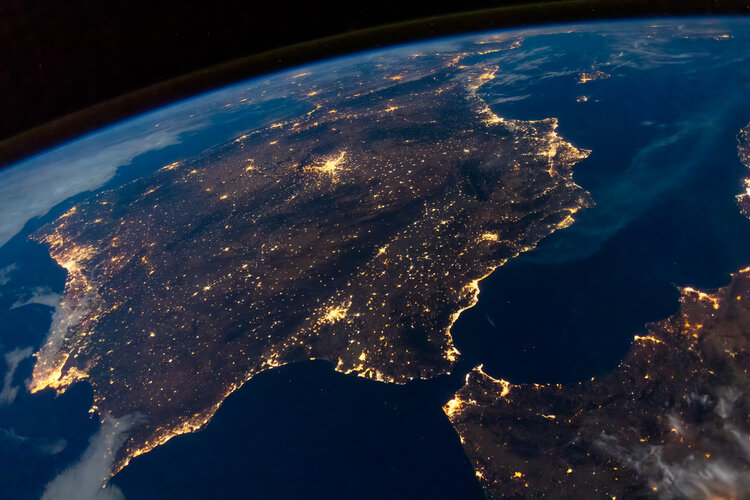
Week in images: 24-28 October 2022
Discover our week through the lens

